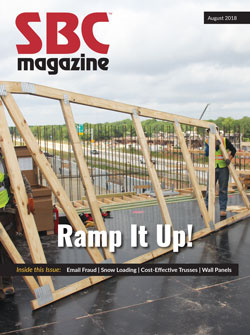Editor's Message: Stop Being Squeezed
Editor's Message: Stop Being Squeezed
If you look at the recent quarterly earnings of the major home builders in the U.S., you will notice a common theme: They’re all making serious money. D.R. Horton’s net income was up 53 percent in the second quarter. Lennar’s revenues rose 67 percent. Pulte Group’s first quarter earnings increased 111 percent. NVR’s earnings were up 57 percent. The list goes on and on. The housing industry is clearly firing on all cylinders, even as labor constraints and building material prices are repeatedly brought up as headwinds for the housing market.
The component manufacturing industry is reportedly as busy as it has ever been, but are you seeing 50-100 percent increases in your earnings like the builders? Why not? The problem isn’t that they are making money. The problem is that builders are trying to convince you the other component manufacturers (CMs) in your market are willing and able to bid more competitively than you. So you sacrifice your margin.
At least one supplier to the housing industry is winning big, however: lumber producers. Whether it’s for new construction or remodeling (which is surging due to increased equity levels and higher home prices), lumber costs are at historic highs. If you look at the recent quarterly earnings of all the major North American mills, you will see the same theme of strong earnings.
Their success has likely played a role in the National Association of Home Builders’ (NAHB) decision to push the notion that the 20 percent tariffs placed on softwood lumber imported from Canada have raised the prices of an average single-family home by $9,000.
That alarming talking point serves a dual purpose. As this concept makes its way through mainstream and social media outlets, it increases the public’s acceptance of higher new home prices. It also prompts lawmakers like U.S. Rep. Kenny Marchant (R-TX) to grill our U.S. Trade Representative as to why he isn’t actively negotiating an end to the trade dispute.
While drawing attention to the harm being done by the tariffs to downstream users of softwood lumber is a good thing, this talking point is misleading on two accounts.
First, as Forest Economic Advisors (FEA) pointed out in their recent analysis, the direct impact trade tariffs have had on the lumber cost of a home is actually much closer to an increase of $3,800. Second, a large portion of the lumber cost increases up to this point have actually been borne by entities like CMs and building material suppliers, who find themselves unable to pass swift increases on to their customers.
The time is right for CMs to embrace basic economics. Your customers are not currently struggling to make a profit. Your lumber suppliers aren’t either. Given how supply and demand functions, there’s no reason why you shouldn’t be benefiting from the strong market as well. Your customers can’t find a more labor- and material-efficient (and hence, more profitable) approach to framing. If the first half of the year hurt your margins, consider how you can improve the latter half of the year by making economic fundamentals work for you too.

